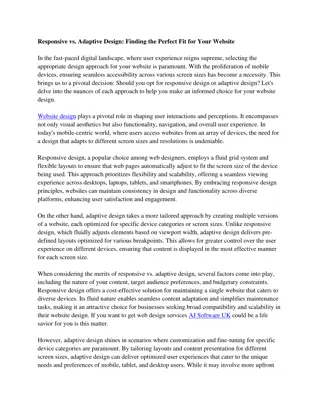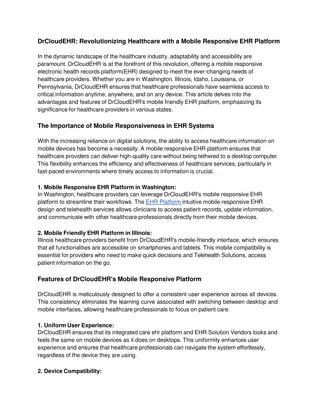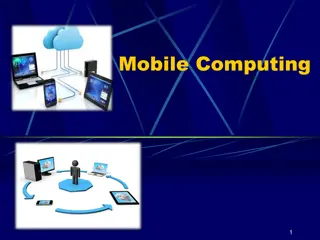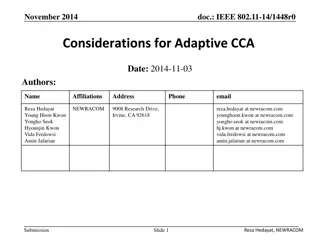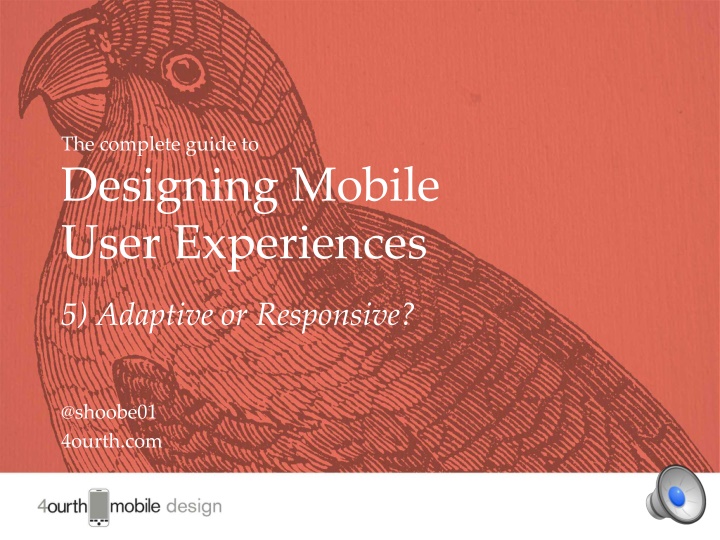
Adaptive vs. Responsive: Exploring Mobile Design Techniques
In this comprehensive guide, discover the nuances of adaptive and responsive design for mobile user experiences. Learn about the principles, strategies, and tools involved in creating optimal presentation layers that cater to diverse platforms and contexts. Explore the significance of device detection, feature detection, and the evolution of mobile-specific design practices. Gain insights into the best practices for improving performance, reducing costs, and enhancing user engagement in the mobile landscape.
Download Presentation

Please find below an Image/Link to download the presentation.
The content on the website is provided AS IS for your information and personal use only. It may not be sold, licensed, or shared on other websites without obtaining consent from the author. If you encounter any issues during the download, it is possible that the publisher has removed the file from their server.
You are allowed to download the files provided on this website for personal or commercial use, subject to the condition that they are used lawfully. All files are the property of their respective owners.
The content on the website is provided AS IS for your information and personal use only. It may not be sold, licensed, or shared on other websites without obtaining consent from the author.
E N D
Presentation Transcript
The complete guide to Designing Mobile User Experiences 5) Adaptive or Responsive? @shoobe01 4ourth.com 1
Responsive vs. Adaptive Not actually at odds with each other. Adaptive The principle of making presentation suitable for the platform and user s context. Adaptive Responsive A subset of adaptation concerned with making content fit the screen size. Responsive RESS Basically adaptive from the POV of responsive. 2
Adaptive is Everything There are many features to address: Not limited to the presentation layer. Part of your strategy, business practice. Best way to improve performance. Reduce costs to you, in bandwidth and storage. 3
Responsive Isnt New That s okay, but we can learn a lot from past practices: Flexible, fluid. Percentage tables. RWD is basically these with new html technologies to make them more effective. CSS Zengarden, 2003. Mobile-specific device detection is older than much Web work in this area. WURFL launched in 2002 to address what was already a problem with device scale and features. 4
Device Detection The key to adaptive techniques is server-side software that detects the device, browser and features. Several existing options: buy not build. Well-established. Some are over 10 years old! Some are free. All provide paid options for support and assistance. Regular (weekly or monthly) updates, usually for free, keep it automatically up to date. Does require installation, and software integration. Will require some CMS to load proper images, if not different text, navigation, etc. 5
Client Side Adaptation Feature Detection Modernizer senses browser and device features directly, but is a limited set and the browser can lie. Client-Side Device Catetorization WURFL.js provides limited device detection without the server hosting. Responsive Images HiSRC lets you call the proper image without device detection or a third party host. 6
Separate Mobile Sites Um sort of. One for mobile, one for desktop. Or, more? Where s the data come from? Are you sure it s separate? Usually adaptive sites, device detection directs to each. Unless it s two URLs. M-dot sites are the devil. Share a link, bookmark, revisit on a different platform? Bots, links, other discovery methods? Usually, send you to one site only, and too often the wrong one. 7
Best Practices Responsive is Fun Adaptive is Best Practice Anyone can do it. Easy to demonstrate and test. Low cost of entry. Basic maintenance is easy. 82% of the top 100 sites, worldwide, use device detection. In 2011. Many more now. Optimised performance and best experience. Inefficient to build at scale and can degrade over time Really, pixel scale only. Performance issues arise from unused code and image scaling. Some initial investment Software maintenance. Weekly or monthly updates to DDR. May require subscribing to a paid service. 10
Adapting Appropriately Adapting to Features Mixed Solutions Feature detection allows adapatation based on specific parts . It is an alternative between device detection and responsive. Some feature can be detected with CSS and JavaScript. Features are also a key part of what is adapted to with device detection. Adaptive is a broad approach, not a technique. Device detection loads geneally custom markup (and some content) but each of these can and should also use responsive principles and technologies to fluidly scale to specific screen sizes. Desktop can live with fixed design, but mobiles need all the space available, so responsive display is important. 11
Features != pages Responsive and adaptive often cause problems for development organizations used to the Web. Estimation, design, specification and development must change back to software-style methods that account for multiple states, instead of page-centric design. Analytics must log device and the loaded view. Test and error reporting need to account for which view is used or bugs will be hard to track down. 15
In Part 6: Information architecture Information architecture. Resilience engineering and design. Navigation. User task flows. 16



